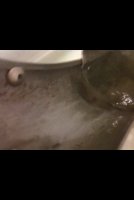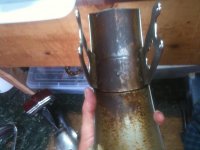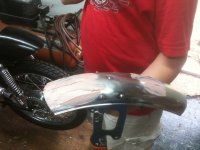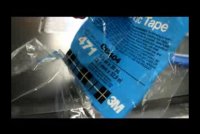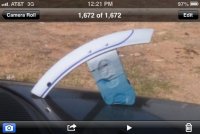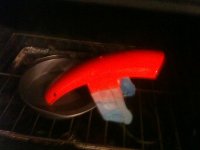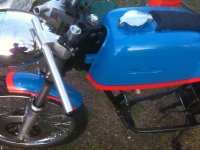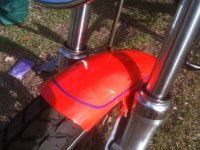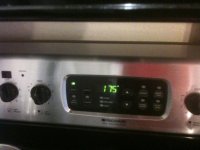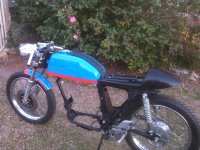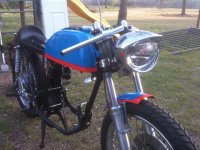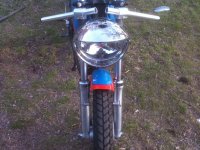We noticed you are blocking ads. DO THE TON only works with community supporters. Most are active members of the site with small businesses. Please consider disabling your ad blocking tool and checking out the businesses that help keep our site up and free.
You are using an out of date browser. It may not display this or other websites correctly.
You should upgrade or use an alternative browser.
You should upgrade or use an alternative browser.
Father Son 75 CB200T Rise From the Ruins
- Thread starter Texasstar
- Start date
alec.korver
Been Around the Block
Umm, you cannot because it may have been off because of worn pistons/rings/valves....etc.... All you can do is measure everything up and use the formula to calculate actual current cc's. Or just ask your machinist how much he took off and alter the numbers with that.
alec.korver said:well where did you mill it off? Did you take it from the deck height of the cylinders? Or did you mill it off the head? I had my head milled. All in all, the head was milled down by the thickness of my gasket. I didn't want to push the envelope to much. However, you probably won't be able to kick start it or electric start it. I can only push start my bike now that I am running about 210psi in each cylinder.
What did you do about the fact that the squish band more or less vanished with machining? 210psi is a lot of compression.
To measure static compression you can start with the assumption that the stock data is correct and work form there, or measure the clearance volume with a burrette and work with real data. Too much compression actually slows down flame rates because the head becomes a cupped pancake shape and that's not very good.
Grinding a little off the top of the barrels on a granite table doesn't take much off - maybe a couple of thousandths.
We machine the pistons to a fixed angle and height around the squish bands and then decide on a head gasket and then machine the head to match the new piston squish angle plus 1 degree. To get that right the barrels have to doweled to the heads to make sure that the squish band is central to the bore. Then we machine the barrels to get the required deck height.
That's how we get great power (relatively speaking) out of corners for such small engines.
Texasstar
Can't is a four letter dirty word
My neighbor Steve said we removed 3 thousandths on the granite table. My wife agreed with you Teazer use a burrette to figure the volume of the combustion chamber of the head however she said that we also need to drop the top of the piston in a graduated cylinder to the point of submersion of what we want measured and see how much is displaced. . Ok Teazer this is where I can't picture it....do we subtract the piston measurement from the head measurement to get the volume of combustion?teazer said:What did you do about the fact that the squish band more or less vanished with machining? 210psi is a lot of compression.
To measure static compression you can start with the assumption that the stock data is correct and work form there, or measure the clearance volume with a burrette and work with real data. Too much compression actually slows down flame rates because the head becomes a cupped pancake shape and that's not very good.
Grinding a little off the top of the barrels on a granite table doesn't take much off - maybe a couple of thousandths.
We machine the pistons to a fixed angle and height around the squish bands and then decide on a head gasket and then machine the head to match the new piston squish angle plus 1 degree. To get that right the barrels have to doweled to the heads to make sure that the squish band is central to the bore. Then we machine the barrels to get the required deck height.
That's how we get great power (relatively speaking) out of corners for such small engines.
Texasstar
Can't is a four letter dirty word
The the volume of combustion/vc of the 175 is 10.98 cubic cm
The vc of the 200 is 12.38 cubic cm
175- (41(52/2)^2 x 3.14 +10980/10980=8.9
200- (41(55.5/2)^2x3.14 +12398/12398=9
If you raise the compression to 12/1 the
175 vc is 7.91 cubic cm or 7.91 ml
200 vc is 9.017 cubic cm or 9.017 ml
So now I have to contact my best man cause he is an engineer and has way to many hours of calculus to tell me how many mm to mill the head...l think we will save that for the next engine lol.
The vc of the 200 is 12.38 cubic cm
175- (41(52/2)^2 x 3.14 +10980/10980=8.9
200- (41(55.5/2)^2x3.14 +12398/12398=9
If you raise the compression to 12/1 the
175 vc is 7.91 cubic cm or 7.91 ml
200 vc is 9.017 cubic cm or 9.017 ml
So now I have to contact my best man cause he is an engineer and has way to many hours of calculus to tell me how many mm to mill the head...l think we will save that for the next engine lol.
Texasstar
Can't is a four letter dirty word
Thanks Teazer! I knew you knew but the knowledge on how is more important than getting the answer! Thanks for making me do the due diligence. What if you fill the penny size circle on the bottom of the valve? I am going to tell my son the reason you want to take calculus is so you can make motorcycles go fasterteazer said:The answer is 1.6mm on a 175 and 1.85mm on a 200, but the valves would hit the piston, so you would deepen the pockets and that would decrease compression, so then you would take some more off....
Texasstar
Can't is a four letter dirty word
Or if we were neighbors we could blow a lot of stuff up...teazer said:Or cut the valve pocket in the piston with a lump in the middle that matches the recess in the valve head ......
Or use flat headed Titanium valves and recess them slightly into the head, or......
You can get a thinner copper gasket from Cometic or just machine some off the block.
In general terms, raising compression increases cylinder pressure which adds torque at all engine speeds. It also raises the speed at which the pressure rises, so it is not unusual to need less spark advance. In some cases, that pressure rise is way too early and hurts top end, but a 200cc Honda can't reach that point, so it's largely academic.
In general terms, raising compression increases cylinder pressure which adds torque at all engine speeds. It also raises the speed at which the pressure rises, so it is not unusual to need less spark advance. In some cases, that pressure rise is way too early and hurts top end, but a 200cc Honda can't reach that point, so it's largely academic.
Texasstar
Can't is a four letter dirty word
Prep: grind, fill, 80 grit, alcohol, prime, 180 grit, alcohol, prime, puddy, 360 grit, alcohol, prime, puddy, 600 grit, alcohol, prime. Take it in the sun, check, double check, puddy, 1000 grit, alcohol, prime, 1000 grit, alcohol, tack, 2 light coats, 3 wet coats, bake 20 minutes 175...repeat for each color. Let cure one week color sand 2000 grit, buff.
Attachments
cyclefreak
Over 1,000 Posts
Looks great!


